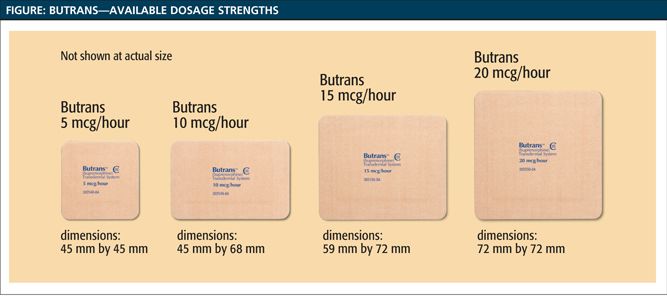Publication
Article
Pharmacy Times
A Pharmacist's Guide to Butrans® (buprenorphine) Transdermal System CIII
This article has been sponsored by Purdue Pharma L.P.
Introduction
This article is intended to provide practical knowledge about Butrans® (buprenorphine) Transdermal System CIII and its position among available prescription analgesics. One of the goals of this article is to help clarify misconceptions regarding the need for a modified DEA registration number in order to prescribe Butrans, and the use of opioid and non-opioid supplemental analgesics in combination with Butrans therapy.1 In addition, this article will review Important Safety Information for Butrans.
WARNING: ABUSE POTENTIAL, LIFE-THREATENING RESPIRATORY DEPRESSION, and ACCIDENTAL EXPOSURE
Abuse Potential
Butrans contains buprenorphine, an opioid agonist and Schedule III controlled substance with an abuse liability similar to other Schedule III opioids, legal or illicit [see Warnings and Precautions (5.1)]. Assess each patient’s risk for opioid abuse or addiction prior to prescribing Butrans. The risk for opioid abuse is increased in patients with a personal or family history of substance abuse (including drug or alcohol abuse or addiction) or mental illness (e.g., major depressive disorder). Routinely monitor all patients receiving Butrans for signs of misuse, abuse, and addiction during treatment [see Drug Abuse and Dependence (9)].
Life-Threatening Respiratory Depression
Respiratory depression, including fatal cases, may occur with use of Butrans, even when the drug has been used as recommended and not misused or abused [see Warnings and Precautions (5.2)]. Proper dosing and titration are essential and Butrans should only be prescribed by healthcare professionals who are knowledgeable in the use of potent opioids for the management of chronic pain. Monitor for respiratory depression, especially during initiation of Butrans or following a dose increase.
Accidental Exposure
Accidental exposure to Butrans, especially in children, can result in a fatal overdose of buprenorphine [see Warnings and Precautions (5.3)].
Parentheses refer to sections in the Full Prescribing Information.
Butrans Transdermal System CIII is the first FDA-approved, 7-day formulation of buprenorphine indicated for the management of moderate to severe chronic pain in patients who require a continuous, around-the-clock opioid analgesic for an extended period of time.1
Limitations of Use: Butrans is not for use: as an as-needed (prn) analgesic; for pain that is mild or not expected to persist for an extended period of time; for acute pain; or for postoperative pain unless the patient is already receiving chronic opioid therapy prior to surgery or if the postoperative pain is expected to be moderate to severe and persist for an extended period of time.1
Butrans is contraindicated in patients with significant respiratory depression; acute or severe bronchial asthma in an unmonitored setting or in the absence of resuscitative equipment; known or suspected paralytic ileus; and hypersensitivity (eg, anaphylaxis) to buprenorphine.1
Butrans may be appropriate for use in opioid-naïve or opioid-experienced patients taking up to 80 mg/day of oral morphine equivalents. The maximum dose of Butrans 20 mcg/hour may not provide adequate analgesia for patients requiring more than 80 mg of oral morphine equivalents per day.1 Refer to the accompanying Full Prescribing Information, section 2, for details regarding how to initiate Butrans as the first opioid analgesic, how to convert from other opioids to Butrans, how to titrate and maintain therapy, and how to discontinue Butrans.
Available Dosage Strengths
Butrans is available in 4 dosage strengths: 5, 10, 15, and 20 mcg/hour (see Figure).

Butrans doses of 10, 15, and 20 mcg/hour are for opioid-experienced patients only. Do not exceed a dose of one 20 mcg/hour Butrans system due to the risk of QTc interval prolongation.1
Buprenorphine Prescribing Laws
Currently, there are 4 different buprenorphine drug delivery systems available in the United States. However, there are significant differences in the indications for these products and, based on federal statute and regulations, restrictions on who can lawfully prescribe some of them for certain indications. States may also have further restrictions on which healthcare professionals can prescribe these various products.
Because Butrans has not been studied and is not approved for use in the management of addictive disorders,1 physicians do not need a Drug Addiction Treatment Act (DATA) waiver or a modified DEA registration number (so-called “X” number) to prescribe Butrans.2 Butrans can be prescribed by any healthcare professional with federal and state authority to prescribe CIII products, and Butrans may be authorized with a written or call-in prescription.
The Role of the Pharmacist
Topics for pharmacists to discuss with prescribers:
Pharmacists can discuss with prescribers available options for chronic pain management, including Butrans, and, if needed, can inform prescribers that they do not need a modified DEA number in order to prescribe Butrans. Pharmacists can inquire whether prescribers wish to prescribe refills of Butrans, because as a CIII product, up to 5 refills are allowable within a 6-month period of time (state regulations may vary).3
Pharmacists may discuss with prescribers what can be done if the patient’s level of pain increases. Prescribers may attempt to identify the source of increased pain, while adjusting the Butrans dose to decrease the level of pain. Because steady-state plasma concentrations are approximated within 72 hours, Butrans dosage adjustments may be done every 3 days. Patients who experience breakthrough pain may require dosage adjustment or rescue medication with an appropriate dose of an immediate-release opioid or non-opioid medication.1
Topics for pharmacists to discuss with patients:
Patients treated with Butrans should be counseled to read the Medication Guide that comes with Butrans before they start using it and with each refill. Pharmacists should counsel patients on the content of the Medication Guide and Instructions for Use.
Pharmacists should reinforce that the patient will need to continue to take Butrans as prescribed and to be in touch with his or her doctor or pharmacist if it is not working effectively. If still experiencing pain, patients should contact their prescriber; he or she may prescribe an additional pain medication for breakthrough pain and/or adjust the dose, if needed. Patients should talk to their prescriber about side effects as well.
Pharmacists should be aware of the patient savings program that has been established to help reduce the cost of Butrans for patients. Two savings offers are available—the Butrans Trial Offer and the Butrans Savings Card, which are accepted at participating pharmacies. The Butrans Trial Offer may cover your patients’ copay for up to $100 on their first prescription for new, commercially insured patients. The Butrans Savings Card may save your patients up to $50 off each subsequent prescription. Patients are responsible for the first $15 and any amount that exceeds the Savings Card offer. Pharmacists may direct patients to Butrans.com for more information as well as eligibility requirements. Alternatively, patients may call 1-866-747-9674, 8:00 am to 8:00 pm EST, Monday through Friday.
Administration of Butrans
Butrans is for transdermal use (on intact skin) only. Each Butrans is intended to be worn for 7 days. Refer patients to the Instructions for Use section of the Medication Guide for proper application, site rotation, and disposal of the Butrans transdermal system.1
Patients should be instructed to:1
- Apply Butrans immediately after removal from the individually sealed pouch.
- Not use Butrans if the pouch seal is broken or the patch is cut, damaged, or changed in any way.
- Apply Butrans to a hairless or nearly hairless skin site. If none are available, the hair at the site should be clipped, not shaven. Do not apply Butrans to irritated skin. If the application site must be cleaned, clean the site with water only. Do not use soaps, alcohol, oils, lotions, or abrasive devices. Allow the skin to dry before applying Butrans.
- Apply Butrans to the upper outer arm, upper chest, upper back, or the side of the chest. These 4 sites (each present on both sides of the body) provide 8 possible application sites. Rotate Butrans among the 8 described skin sites.
- Wait a minimum of 21 days before reapplying to the same skin site after removal of Butrans.
If problems with adhesion of Butrans occur, the edges may be taped with first aid tape. If Butrans falls off during the 7-day dosing interval, dispose of the transdermal system properly and place a new Butrans on at a different skin site.1
When changing the system, instruct patients to remove Butrans, fold it over on itself, and flush it down the toilet. Alternatively, Butrans can be sealed in the Patch-Disposal Unit provided and then disposed of in the trash. Instruct patients to never throw Butrans away in the trash without sealing it in the Patch-Disposal Unit.1
Warnings and Precautions
The 3 main elements of the Boxed Warning, which include abuse potential, life-threatening respiratory depression, and accidental exposure, have been discussed earlier in the boxed warning. When considering Butrans treatment, the following additional Warnings and Precautions should be reviewed during the patient’s risk assessment:
- Respiratory depression is more likely to occur in elderly, cachectic, or debilitated patients, as they may have altered pharmacokinetics. Monitor such patients closely, particularly when initiating and titrating Butrans and when Butrans is given concomitantly with other drugs that depress respiration.1
- Monitor patients with significant chronic obstructive pulmonary disease, cor pulmonale, a substantially decreased respiratory reserve, hypoxia, hypercapnia, or preexisting respiratory depression for respiratory depression, particularly when initiating therapy and titrating with Butrans. Even usual therapeutic doses of Butrans may decrease respiratory drive to the point of apnea.1
- Hypotension, profound sedation, coma, or respiratory depression may result if Butrans is added to a regimen that includes other CNS depressants, alcohol, or illicit drugs.1
- Avoid in patients with Long QT Syndrome, family history of Long QT Syndrome, or those taking Class IA or Class III antiarrhythmic medications.1
- Butrans may cause severe hypotension including orthostatic hypotension and syncope in ambulatory patients.1 Monitor patients after initiating or titrating.
- Monitor patients who may be susceptible to the intracranial effects of CO2 retention for signs of sedation and respiratory depression, particularly when initiating therapy with Butrans. Opioids may also obscure the clinical course in a patient with a head injury.1
- Although not observed in Butrans chronic pain clinical trials, cases of cytolytic hepatitis and hepatitis with jaundice have been observed in individuals receiving sublingual buprenorphine for the treatment of opioid dependence. For patients at increased risk of hepatotoxicity, obtain baseline liver enzyme levels and monitor periodically during treatment with Butrans.1
- Cases of acute and chronic hypersensitivity to buprenorphine have been reported both in clinical trials and in the post-marketing experience.1
- Avoid exposing the Butrans application site and surrounding area to direct external heat sources. Potential exists for temperatureâ€dependent increases in buprenorphine released from the system resulting in possible overdose and death.1
- Monitor patients wearing Butrans who develop fever or increased core body temperature due to strenuous exertion for opioid side effects and adjust the Butrans dose if signs of respiratory or central nervous system depression occur.1
- Avoid the use of Butrans in patients with paralytic ileus and other GI obstructions. Monitor patients with biliary tract disease, including acute pancreatitis, for worsening symptoms.1
- Buprenorphine may aggravate convulsions in patients with convulsive disorders, and may induce or aggravate seizures in some clinical settings. Monitor patients with a history of seizure disorders for worsened seizure control during Butrans therapy.1
- When discontinuing Butrans, gradually taper the dose. Do not abruptly discontinue Butrans.1
- Butrans may impair the mental and physical abilities needed to perform potentially hazardous activities such as driving a car or operating machinery. Warn patients not to drive or operate dangerous machinery unless they are tolerant to the effects of Butrans and know how they will react to the medication.1
Adverse Reactions
The most common adverse reactions (≥5%) reported by patients treated with Butrans in the clinical trials were nausea, headache, application site pruritus, dizziness, constipation, somnolence, vomiting, application site erythema, dry mouth, and application site rash.1
In rare cases, severe application site skin reactions with signs of marked inflammation including “burn,” “discharge,” and “vesicles” have occurred. Time of onset varies, ranging from days to months, following the initiation of Butrans treatment. Patients should promptly report severe application site reactions and discontinue therapy.1
Misuse, Abuse, and Diversion of Opioids
Butrans contains buprenorphine, a mu opioid partial agonist and Schedule III controlled substance with an abuse potential similar to other Schedule III opioids. Butrans can be abused and is subject to misuse, abuse, addiction, and criminal diversion.1
Abuse of Butrans poses a hazard of overdose and death. This risk is increased with compromise of the Butrans Transdermal System and with concurrent abuse of alcohol or other substances. Butrans has been diverted for non-medical use. All patients treated with opioids, including Butrans, require careful monitoring for signs of abuse and addiction, because use of opioid analgesic products carries the risk of addiction even under appropriate medical use.1
Butrans may be diverted for non-medical use into illicit channels of distribution. Careful record keeping of prescribing information, including quantity, frequency, and renewal requests, as required by state law, is strongly advised.1
The risks of misuse and abuse should be considered when prescribing or dispensing Butrans. Concerns about abuse and addiction should not, however, prevent the proper management of pain. Treatment of pain should be individualized, balancing the potential benefits and risks for each patient.1
Please read the Full Prescribing Information, including Boxed Warning.
REFERENCES
- Butrans [Full Prescribing Information]. Stamford, CT: Purdue Pharma LP; 2013.
- Buprenorphine: frequently asked questions about buprenorphine and the Drug Addiction Treatment Act of 2000 (DATA 2000). Substance Abuse and Mental Health Administration (SAMHSA) website. http://buprenorphine.samhsa.gov/faq.html. Accessed August 16, 2013.
- Title 21 Code of Federal Regulations, Part 1306 — Prescriptions: Controlled Substances Listed in Schedules III, IV, and V: Section 1306.22 Refilling Prescriptions. www.deadiversion.usdoj.gov/21cfr/cfr/1306/ 1306_22.htm. Accessed October 31, 2013.







